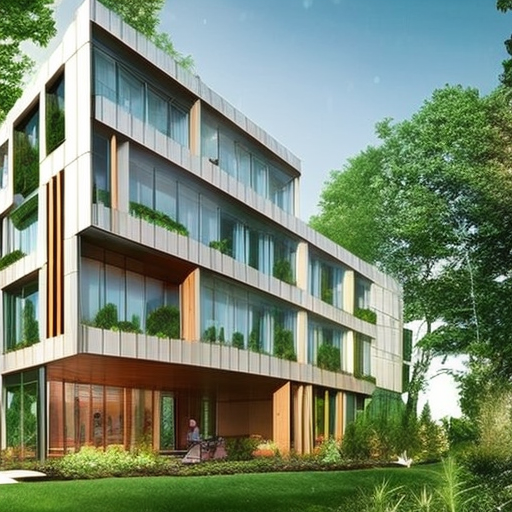Sustainable Architecture: Designing for a Greener Future
Sustainable architecture, also known as green architecture or eco-friendly architecture, is an approach to building design that aims to minimize the negative environmental impact of buildings while maximizing their positive contribution to the surrounding ecosystem. It involves the use of sustainable materials, energy-efficient systems, and innovative design strategies to create structures that are environmentally responsible, socially beneficial, and economically viable.
Key Principles of Sustainable Architecture
1. Energy Efficiency: Sustainable architecture focuses on reducing energy consumption by incorporating passive design strategies such as proper insulation, natural ventilation, and daylighting. It also promotes the use of energy-efficient appliances, lighting systems, and renewable energy sources like solar panels and wind turbines.
2. Water Conservation: Sustainable buildings aim to minimize water usage through the implementation of water-efficient fixtures, rainwater harvesting systems, and graywater recycling. These measures help reduce the strain on local water resources and contribute to overall water conservation efforts.
3. Material Selection: Sustainable architecture emphasizes the use of environmentally friendly and locally sourced materials that have a low carbon footprint. This includes materials with high recycled content, such as reclaimed wood and recycled steel, as well as those that can be easily recycled or reused at the end of their lifecycle.
4. Waste Reduction: Sustainable buildings are designed to minimize waste generation during construction and operation. This involves implementing strategies such as construction waste management plans, recycling programs, and the use of modular construction techniques that allow for easy disassembly and reconfiguration.
5. Biodiversity and Ecosystem Integration: Sustainable architecture seeks to integrate buildings harmoniously into their natural surroundings, preserving and enhancing local ecosystems. This can be achieved through the incorporation of green roofs, vertical gardens, and the use of native plants that support local wildlife and promote biodiversity.
6. Social Considerations: Sustainable architecture takes into account the social impact of buildings on their occupants and the surrounding community. It prioritizes the creation of healthy and comfortable indoor environments through the use of non-toxic materials, good indoor air quality, and access to natural light and views. It also promotes community engagement and encourages the development of inclusive and accessible spaces.
Benefits of Sustainable Architecture
1. Environmental Benefits: Sustainable architecture reduces greenhouse gas emissions, minimizes resource depletion, and helps protect natural habitats. It contributes to climate change mitigation and adaptation efforts by reducing energy demand and promoting the use of renewable energy sources.
2. Economic Benefits: While sustainable buildings may have higher upfront costs, they offer long-term financial benefits through reduced energy and water bills. Additionally, sustainable architecture can stimulate local economies by creating jobs in the renewable energy and green construction sectors.
3. Health and Well-being: Sustainable buildings provide healthier indoor environments by minimizing exposure to harmful pollutants and improving air quality. Access to natural light, views of nature, and well-designed spaces can enhance occupants’ well-being, productivity, and overall quality of life.
4. Resilience and Adaptability: Sustainable architecture promotes the use of resilient design strategies that can withstand natural disasters and climate change impacts. It encourages the integration of renewable energy systems, energy storage, and smart technologies to enhance the resilience and adaptability of buildings.
5. Leadership and Innovation: Sustainable architecture drives innovation in the construction industry by challenging traditional design and construction practices. It encourages the development of new technologies, materials, and design strategies that can be applied to create more sustainable and resilient buildings.
Conclusion
Sustainable architecture offers a holistic approach to building design that considers the environmental, social, and economic aspects of construction. By incorporating energy-efficient systems, water conservation measures, and sustainable materials, sustainable buildings can significantly reduce their environmental impact while providing healthier and more comfortable spaces for occupants. As the world faces increasing environmental challenges, sustainable architecture plays a crucial role in creating a greener and more sustainable future.












